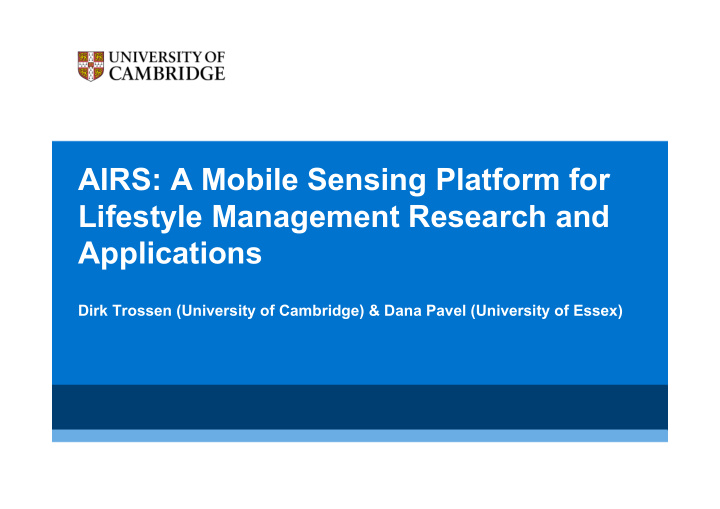



AIRS: A Mobile Sensing Platform for Lifestyle Management Research and Applications Dirk Trossen (University of Cambridge) & Dana Pavel (University of Essex)
Outline • Scenarios & Challenges • Main Platform Abstractions • Supported Sensors • Supported User Interactions • Insights from Experiments
Possible Scenarios • Lifestyle management • Activity recording • Aim at stress management, activity management, … • Use available mobile platforms and sensors • Wardriving scenarios • Correlate information from mobiles, here GPS and WLAN/BT • User research • Get insight into usage of mobile device in certain conditions
What is the WSN Here? • 4 billion mobile subscribers • Some countries approaching 50% smartphone penetration • Smartphone capabilities staggering • GHz speeds in multi-cores • >1GB RAM • Gbyte storage • Programmed like any other general processing environment -> Smartphones are the largest WSN available at the moment
Challenges • Battery life • Mobile devices are for personal use! • Configurability • Allow for trading off requirements of scenario and needs of end users • Support for storing and synchronisation • Accommodate privacy and security issues! • Connectivity • Do not assume always-on, cater to different models
Challenges (2) • Extensibility • Support future information sources as well as processing algorithms • Support user interactions • Blend into available mobile UI framework • Utilise users’ knowledge! • Sharing • Important in the age of social networks!
Objective of Our Contribution • Design and develop a mobile device platform for recording a large variety of information sources, addressing the aforementioned challenges • Make the platform available to the wider community to drive adoption towards a common framework rather than continuing individual realisations
Platform Choice: Android • Allows for easy background recording • Exposes many system-level sources of information • Allows easy access to, e.g., WLAN, BT • Allows for integration of BT/USB accessories • Support for widgets on launcher screen • Larger user base • More device form factors
Main Platform Abstractions
Main Platform Abstractions
Main Platform Abstractions
Main Platform Abstractions
Supported Sensors • 60+ sensors supported • Most sensors realised via callbacks • Abstracted by Handler interface • Integrating new sensors possible • Stored in Sqlite DB
Supported User Interactions • Visualise through timeline or maps • Annotate through widgets utilising the user’s knowledge of the current context • Enable Handlers to expose setting UI • Sharing of individual ! ! ! values
Conducted User Experiments • Realistic usage : Lifestyle monitoring scenario • Feedback from usage into extending the platform • GPS, BT & audio plus many other callback sensors • Controlled setting: wardriving scenario • Getting insight into battery consumption of ‘heavy’ sensors • GPS & WLAN with 15s and 30s intervals, no personal use of devices • Challenges: Repeatability of experiments & Differences in device platforms
Battery Usage • GPS, WLAN, BT and audio recording major power sources • Settings influence the consumption • Battery usage around 6-8% average per hour ! • Higher variance for lifestyle Used devices: scenario due to end user usage • Galaxy Nexus running Android 4.04 for lifestyle scenario • Two Galaxy S running Android 2.3.5 for wardriving scenario
Feedback into Design • Support for configurability important since needs change over time • Configure what is recorded, when, with what sampling rate/accuracy • Template-based recording possible • Support for user contributions important to complement recordings • Free text allows for user-level semantics to be added • Mood annotations prove to be useful and accurate
Summary: AIRS Platform - Features • Supports integration of a wide range of current and future sensors • Provides configuration interfaces for settings and choosing sensors • Provides quick start mode from the main application launcher screen, using the last selected sensors (if they are still available) • Visualises current value or historical timelines • Provides two widgets, one for free-text user annotations and one for mood-related annotations • Supports local recording with values stored in a phone-local database • Support remote recording with data sent to a remote server
Conclusions • Design & implement a mobile device platform ready for use • Used in research projects on lifestyle management • Extensible in terms of supported information sources • Make software available to wider community • Available for download in Google Play Store • Currently >5500 downloads • Allows for recording scenarios without depleting battery • Usage-based experiments show possible day-long recordings!
More Information • AIRS @ PlayStore • PAL project on lifestyle monitoring • Or email to dirk.trossen@cl.cam.ac.uk
Recommend
More recommend